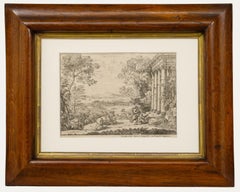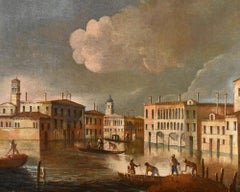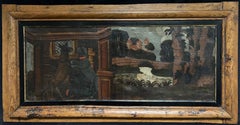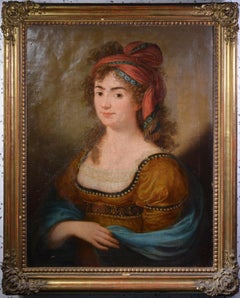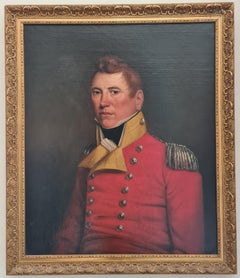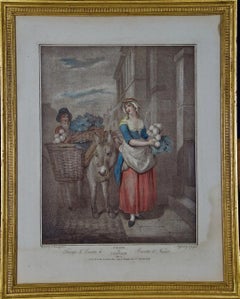18th Century Art
to
573
3,373
1,086
376
241
301
Overall Width
to
Overall Height
to
7,534
21,272
158,709
232,773
1,969
2,236
4,911
6,412
5,806
13,276
19,657
25,624
18,277
13,568
5,378
2,282
1,164
42
15
8
2
1
2,726
2,166
370
3,159
1,575
1,077
901
850
705
613
442
414
382
318
271
256
186
170
155
143
127
124
119
3,178
1,226
895
775
455
160
127
86
81
72
1,231
3,066
3,381
838
Period: 18th Century
Claude Le Lorrain (1600-1682) - Framed 18th Century Etching, Mercury and Argus
Located in Corsham, GB
A finely detailed etching by Claudio Gellee, better known as Claude Lorrain (1600-1682). This print is a later restrike of a seventeenth-century original, and depicts the myth of Mer...
Category
18th Century Art
Materials
Etching
View Venice Landscape Tironi 18th Century Paint Oil on canvas Old master Italy
Located in Riva del Garda, IT
Francesco Tironi (Venice, circa 1745 - 1797)
View of Venice with the entrance to Cannaregio
oil on canvas 59 x 75 cm with frame 72 x 88 cm
Work accompanied by a descriptive n...
Category
Old Masters 18th Century Art
Materials
Oil
$11,823 Sale Price
20% Off
Huge 18th Century French Oil Painting Dogs Fighting Medieval Castle Wooden Frame
Located in Cirencester, Gloucestershire
Fighting Dogs
French Provincial School, 18th century, unsigned
oil on canvas, framed in period antique wooden frame (walnut?)
Framed: 26 x 51 inches
Canv...
Category
Old Masters 18th Century Art
Materials
Oil, Canvas
Antique 18th Century Neoclassical Oil Portrait Young Lady Turban Unknown Master
Located in Stockholm, SE
This captivating oil portrait from the late 18th to early 19th century depicts a mysterious charming young woman, painted by an unknown but clearly professional master, presumably Fr...
Category
Realist 18th Century Art
Materials
Gold Leaf
18th Century Oil on Canvas Portrait, Major Alexander Brown in Military Uniform.
By Sir David Wilkie
Located in Cotignac, FR
18th Century Military portrait of a young officer in Napoleonic period military dress. The painting is not signed but the subject is Major Alexander Brown. The work is oil on canvas later mounted on board and presented in a fine 'Regence style' carved gilt frame. There are labels to the back referring to the subject, 'Major Brown of Trinity' and a framers trade label from Edinburgh.
A magnificent and imposing portrait of a young military officer in the prime of his life. His red uniform adorned with fine buttons, fringed epaulettes and high gilt collar. His ruddy complexion offset by his stylish hair, a quiff and swept forward to the sides as was the fashion at the time.
Sir David Wilkie RA (18 November 1785 – 1 June 1841) was a Scottish painter, especially known for his portraits, including formal royal ones, and scenes from his travels to Europe and the Middle East. He painted successfully in a wide variety of genres, including historical scenes. His main base was in London, but he died and was buried at sea, off Gibraltar, returning from his first trip to the Middle East. He was sometimes known as the "people's painter".
He was Principal Painter in Ordinary to King William IV and Queen Victoria. Apart from royal portraits, his best-known painting today is probably The Chelsea Pensioners Reading the Waterloo Dispatch of 1822 in Apsley House.
Sir David Wilkie was actually admitted in 1799 (despite only being 14) through the influence of the Earl of Leven...
Category
Old Masters 18th Century Art
Materials
Canvas, Oil, Board
An Engraving from the Series 'The Cries of London': "Turnips & Carrots"
Located in Alamo, CA
A beautifully framed hand-colored engraving from the famous "Cries of London" series, depicting the lives and professions of the common people of 18th ...
Category
Naturalistic 18th Century Art
Materials
Engraving
Pierre Auguste Renoir, "Mère et Enfant , " rare drypoint
Located in Chatsworth, CA
Pierre Auguste Renoir
Mère et Enfant, 1896
Drypoint in brown and green
From a very rare edition of 100 impressions on cream-toned Van Gelder laid paper
Reference: Delteil #10
Printed...
Category
Impressionist 18th Century Art
Materials
Drypoint
Church of St. Costanza, Rome: An 18th Century Piranesi Architectural Etching
Located in Alamo, CA
This is a framed 18th century Giovanni Battista Piranesi etching entitled: "Veduta interna del Sepocro di Santa Costanza, fabbricat...
Category
Old Masters 18th Century Art
Materials
Etching
An equestrian portrait of Field Marshal Sir John Ligonier, 1st Earl of Ligonier
By David Morier
Located in Stoke, Hampshire
David Morier (c.1705–1770 London)
An equestrian portrait of Field Marshal Sir John Ligonier, 1st Earl of Ligonier (1680–1770)
Oil on canvas
Canvas size - 40 x 50 in
Framed size - 48 ...
Category
Old Masters 18th Century Art
Materials
Oil
French Old Master The Garden of Gethsemane Unusual Shape Panel
Located in Cirencester, Gloucestershire
Artist/ School: French School, 18th century
Title: The Garden of Gethsemane
Medium: oil painting on wooden panel, unframed.
painting: measurem...
Category
Old Masters 18th Century Art
Materials
Oil
Portrait of an Old Bearded Man With a Black Cap
Located in Stockholm, SE
We are pleased to offer a captivating portrait, most likely painted in the late 18th century, attributed to an artist within the circle of Christian Wilhelm Ernst Dietrich. This oil ...
Category
Old Masters 18th Century Art
Materials
Oil, Wood Panel
Borne - European School 18th Century Oil, Anna and Adelaide
Located in Corsham, GB
A delightfully tender 18th-century family portrait depicting mother and daughter - Anna and Adelaide - with their cherished spaniel. The artist beautifully conveys the intimate bond ...
Category
18th Century Art
Materials
Oil
Animated Farm and Windmill Scenery
Located in Genève, GE
Work on canvas
Black wooden frame
51 x 73 x 5 cm
Category
18th Century Art
Materials
Oil
Giuseppe Zais (Venetian master) - 18th century landscape painting - Khnigts
By Giuseppe Zais (Canale d'Agordo, Belluno 1709 - Treviso 1781)
Located in Varmo, IT
Giuseppe Zais (Forno di Canale 1709 - Treviso 1784) - Landscape with Resting Horsemen.
37.5 x 97.5 cm unframed, 45.5 x 104.5 cm with frame.
Oil on canvas, in a carved and gilded wo...
Category
Rococo 18th Century Art
Materials
Canvas, Oil
18th Century French Oil Artist Painting Nude Model Classical Garden Scene
Located in Cirencester, Gloucestershire
The Artist and his Model
French School, 18th century
oil on canvas, framed
Framed: 14 x 17 inches
Board: 11 x 14 inches
Provenance: private collection, France
Condition: very good co...
Category
Rococo 18th Century Art
Materials
Oil
Excuela española (XVIII) - Escena bíblica - Óleo sobre tela
Located in Sant Celoni, ES
Como pueden apreciar, la obra no va firmada, es de autor anónimo
Se presenta sin enmarcar la pintura
El estado de la obra se puede ver, presenta varias faltas de pintura y precisar...
Category
Old Masters 18th Century Art
Materials
Oil
$957 Sale Price
20% Off
Huge 18th Century Italian Old Master Oil Painting Still Life Fruit Flowers & Jug
Located in Cirencester, Gloucestershire
Classical Still Life of Fruit in Basket with other objects
Italian artist, 18th century
oil on canvas, unframed
canvas: 24.5 x 33 inches
provenance: private collection, UK
condition:...
Category
Old Masters 18th Century Art
Materials
Oil
18th Century European Portrait of Saint John the Baptist as a Child.
Located in SANTA FE, NM
18th Century European Portrait of a Child Saint John the Baptist
Oil on Canvas
19 x 14 1/4 inches
This lovely and sensitively painting has been examined by a professional restorer w...
Category
Old Masters 18th Century Art
Materials
Canvas, Oil
$5,225 Sale Price
44% Off
Patas A Bandeau Noir - Etching by Jacques Mesnil - 1771
Located in Roma, IT
Patas A Bandeau Noir is an etching realized in 1771 by Jacques Mesnil.
Signed in plate.
The artwork Belongs to the suite "Histoire naturelle, générale et particulière avec la descr...
Category
Modern 18th Century Art
Materials
Etching
Portrait of a Young Lady with Fruit - British Old Master art oil painting
Located in Hagley, England
This lovely British 18th century portrait oil painting, with excellent provenance, is attributed to circle of George Henry Harlow. Painted circa 1760, it is a standing half length po...
Category
18th Century Art
Materials
Oil
$4,905 Sale Price
20% Off
18th Century French Portrait of Mysterious Man Oil on Canvas for restoration
Located in Cirencester, Gloucestershire
Portrait of a Gentleman
French School, 18th century
oil on canvas, unframed
canvas : 25 x 20 inches
provenance: private collection, France
condition: the painting is in sound conditi...
Category
Old Masters 18th Century Art
Materials
Oil
Escuela Valenciana (XVIII), tras Juan de Juanes - Inmaculada Concepción
Located in Sant Celoni, ES
La obra no va firmada
El estado de conservación de puede ver, es bastante bueno, solo aconsejaría una limpieza ya que está un poco sucia, pero por lo demas, muy aceptable
Se presen...
Category
Old Masters 18th Century Art
Materials
Oil
$1,531 Sale Price
20% Off
Madonna Child Conca 17/18th Century Paint Oil on copper Old master Roman school
Located in Riva del Garda, IT
Sebastiano Conca (Gaeta 1680 – Naples 1764) circle
Madonna and Child
Oil on copper
26 x 20 cm In high-quality period frame 72 x 50 cm
The work depicts the Madonna lovingl...
Category
Old Masters 18th Century Art
Materials
Oil
$5,974 Sale Price
20% Off
Continental School 18th Century Watercolour - Architectural Drawing
Located in Corsham, GB
A charming watercolor Baroque architectural study. Unsigned. Presented in a gilt frame and wash line mount. On Laid paper.
Category
18th Century Art
Materials
Watercolor
$328 Sale Price
20% Off
Fine 18th Century British Portrait of an Aristocratic Lady, Large oil painting
Located in Cirencester, Gloucestershire
Circle of Thomas Hudson (1701-1779) British.
18th Century Bust Portrait of a Lady,
Oil on Canvas, Inscribed on a label verso,
canvas: 30" x 25" (76.2 x 63.5cm).
frame: 30 x 25 in...
Category
Old Masters 18th Century Art
Materials
Canvas, Oil
Portrait of a Gentleman & Dog - Fine Georgian English Old Master Oil Painting
Located in Sevenoaks, GB
A beautiful late 18th or very early 19th century English oil on copper portrait of a gentleman with his hound.
Excellent quality Georgian period work which is unusually painted on c...
Category
Old Masters 18th Century Art
Materials
Copper
Le Loup - Etching by Jean C. Baquoy - 1771
Located in Roma, IT
Etching realized by Jean Charles Baquoy in 1771.
It belongs to the first edition of the suite "Histoire Naturelle de Buffon".
Good conditions with slight foxing.
Category
Modern 18th Century Art
Materials
Etching
Huge 1700's Dutch Old Master Oil Painting Elegant Court Figures Musical Soiree
Located in Cirencester, Gloucestershire
Artist/ School: Dutch School, early 1700's.
Title: Elegant Court Figures at a Musical Soiree.
Medium: oil painting on canvas, unframed.
Size: painting: 40 x 49.5 inches
Provenanc...
Category
18th Century Art
Materials
Canvas, Oil
18th century Venetian Still life of flowers, classical vase on a marble ledge
Located in Woodbury, CT
The Pseudo-Guardi was an unidentified Venetian painter from the 18th or early 19th century who closely imitated the style of Francesco Guardi (1712–1793), one of the great Venetian v...
Category
18th Century Art
Materials
Canvas, Oil
Letter of the Alphabet A - Etching by Luigi Vanvitelli - 18th Century
Located in Roma, IT
Letter of the Alphabet A from the series "Antiquities of Herculaneum", is an etching on paper realized by Luigi Vanvitelli in the 18th century.
Signed on the plate.
Good conditions...
Category
Old Masters 18th Century Art
Materials
Etching
18th Century French Oil Painting Tavern Scene Interior Merry Making Figures
Located in Cirencester, Gloucestershire
Merry Makers in the Tavern
French School, 18th century
oil on canvas
canvas: 8 x 11 inches
provenance: private collection, France
condition: good and sound condition
Category
Old Masters 18th Century Art
Materials
Oil, Canvas
Landscape River Zuccarelli 18th Century Paint Oil on canvas Old master Italy Art
By Francesco Zuccarelli (Pitigliano 1702 - Florence 1788)
Located in Riva del Garda, IT
Francesco Zuccarelli (Pitigliano 1702 - Florence 1788), circle of
Landscape with river and resting shepherds
First half of the 18th century
oil painting on canvas
cm. 60 x 93, wit...
Category
Old Masters 18th Century Art
Materials
Oil
$6,098 Sale Price
20% Off
George II, King of England, royalty portrait engraving, circa 1780
Located in Melbourne, Victoria
'George II'
Copper-line engraving by Pierre Francois Basan (1723-1797) after Founan.
Basan (1723-1797) was a French engraver and publisher.
George II (1683-1760) was King of Great Britain and Ireland, Duke of Brunswick-Leneburg (Hanover) and Archtreasurer and Prince-Elector of the Holy Roman Empire from 11 June 1727 until his death. He was the last British monarch to have been born outside Great Britain, and was famous for his numerous conflicts with his father and, subsequently, with his son. As king, he exercised little control over policy in his early reign, the government instead being controlled by Great Britain's de facto first Prime Minister, Sir Robert Walpole...
Category
Renaissance 18th Century Art
Materials
Engraving
Large 18th Century European Oil Painting Portrait of Noble Lady Lace Collars
Located in Cirencester, Gloucestershire
Portrait of a Noble Lady
European School, 18th century
oil on canvas, framed
framed: 37.5 inches
canvas: 30 x 24.5 inches
provenance: private collection, France
condition: very good ...
Category
Old Masters 18th Century Art
Materials
Oil, Canvas
18thC English School Gentleman In A Red Velvet Coat, Oil On Canvas, Portrait
Located in Cheltenham, GB
US buyers pay no import tariffs on this painting.
This early 18th-century English School portrait depicts Thomas Stanley wearing a striking red velvet suit, white cravat and powdere...
Category
English School 18th Century Art
Materials
Canvas, Oil
Grand Tour 18th Century Veduta Capriccio Painting, After Gennaro Greco
Located in Cotignac, FR
A fine, large 18th century veduta capriccio scene with temple ruins after Gennaro Greco from the circle of Pietro Cappelli. The painting is presented in a more modern carved gilt woo...
Category
Baroque 18th Century Art
Materials
Canvas, Oil
$9,095 Sale Price
20% Off
Mughal School, 18th century Emperor Jangahir on a pleasure boat with his harem a
Located in Middletown, NY
Emperor Jahangir depicted with his harem attendees aboard a pleasure cruise, the water filled with lotus blossoms; symbols of paradise itself.
Circa 1750. Gouache and ink with gold ...
Category
Rajput 18th Century Art
Materials
Gold
18th Century French Rococo Old Master Ink Drawing Nativity Scene
Located in Cirencester, Gloucestershire
The Birth
French Rococo School, mid 18th century
sepia ink on paper over board, framed behind glass.
framed: 13 x 11 inches
painting : 8 x 6 inches
Provenance: private collection, B...
Category
Rococo 18th Century Art
Materials
Watercolor, Ink
View of Castello dell'Acqua Felice - Etching by G. B. Piranesi - 1751
Located in Roma, IT
View of Castel of Acqua Felice is an original etching realized by the italian artist Giovanni Battista Piranesi in 1751.
Very precoius and rare lifetime impression. Roman edition. I...
Category
Old Masters 18th Century Art
Materials
Etching
"Turnip"
By Giacomo Ceruti
Located in Edinburgh, GB
Giacomo Ceruti, known as Il Pitocchetto (1698-1767) – “Turnip”
Medium: Oil on canvas
Dimensions: 204 x 124 cm (unframed)
Provenance: Private collection
This remarkable painting, “T...
Category
Realist 18th Century Art
Materials
Canvas, Oil
$50,000
18th Century Oil - Grape Gatherer
Located in Corsham, GB
A charming oil study depicting a woman gathering grape vines in a field. Part of a pair of oils depicting women harvesting. Unsigned. On panel.
Category
18th Century Art
Materials
Oil
Portrait Of A Nude Male, 18th Century School of Jacques-Louis David (1748-1825)
Located in Blackwater, GB
Portrait Of A Nude Male, 18th Century
School of Jacques-Louis David (1748-1825)
18th Century French School portrait of a nude male, oil on paper laid to board. Excellent quality an...
Category
18th Century Art
Materials
Oil, Paper
Portrait of Anne Evelyn - British 18thC Old master oil painting excellent prov.
Located in Hagley, England
This stunning British 18th century Old Master portrait oil painting, with exceptional provenance, is by noted artist George Romney. It was painted in 1788, commissioned by James Evelyn of Felbridge as it is of his younger daughter Anne, aged 20 years old. James was a Doctor of Law and Anne's mother was his second wife, Jane. Felbridge house, Anne's home, was in the village of Godstone in Surrey. This superb oil painting is a seated portrait of Anne, wearing a white dress with a green sash, her forearms exposed and her hands in her lap. Anne is blessed with the most wonderful long auburn curly hair and is visually stunning. Her body is partly turned away from the artist/viewer and she is slightly gazing down at us with confident, clear eyes. Anne is pictured in a landscape with a dramatic sky behind her. Romney's brushwork on her dress, hair and the background is superb. The delicate detailing of her facial features is also stunning. Sometimes Old Master portraits can be a little staid, but this one of Anne with her wild auburn hair and bold look is just magnificent. This is a fantastic example of George Romney's work and of an 18th century British Old Master with exceptional detailed provenance.
Name plate states: Anne, younger daughter of James Evelyn of Fellbridge Esq. 1788, aged 20. Romney.
Provenance. With Charles Cecil Cope Jenkinson, 3rd Earl of Liverpool (1784-1851)
With The Hon. Henry Berkeley Portman (1860-1923),
Later 3rd Viscount Portman; with Emma, Viscountess Portman (1862-1929)
By 1926; with her daughter Lady Moyra Dawson-Damer (1897-1962)
Thence by family descent.
Painted in 1788. There are various labels verso.
Mentioned in Lord Hawkesbury's Catalogues of Portraits at Compton Place and at Buxted Park, in Sussex, 1903, p.18, no. 3, at Buxted Park, as in the 'Dining Room, South Wall'.
Further Bibliography: Gower (R. S.) Romney, London, 1904, p. 175 Kidson (Alex) George Romney, A Complete Catalogue of his Paintings, New Haven and London: Yale University Press, 2015, I, p. 205, no. 422 (illus).Ward (Humphrey) and Roberts (William) Romney: A Biographical and Critical Essay, London: T Agnew & Sons, 1904, p. 51
Condition. Oil on canvas. Image size 30 inches by 24 inches and in good condition.
Frame. Housed in an ornate gilt frame with name plate, 37 inches by 31 inches and in good condition.
George Romney (1734-1802) was born in Dalton-on-Furness, Lancashire, on 15 December 1734, the third of the eleven children of John Romney and Anne Simpson. Leaving school at the age of eleven, he worked for eight years in his father's cabinetmaking workshop before being apprenticed to a local painter, Christopher Steele, with whom he served for two years, from 1755 to 1757, in Kendal, York, and Lancaster. He married a Kendal girl, Mary Abbot...
Category
Old Masters 18th Century Art
Materials
Oil
$98,101 Sale Price
20% Off
Antique French Miniature Portrait of Lady Biographical details with painting
Located in Cirencester, Gloucestershire
Miniature Portrait
French School, late 18th/ early 19th century
framed: 5.5 x 5.5 inches
board: 2 x 2 inches
provenance: private collection, France
condition: very good and sound c...
Category
Old Masters 18th Century Art
Materials
Watercolor
Dutch School 18th Century Oil - A Meal at the Inn
Located in Corsham, GB
A charming 18th-century tavern scene, depicting peasants gathered around a table enjoying a meal. Unsigned. Presented in gilt frame with unique corner ornaments featuring phoenix, ac...
Category
18th Century Art
Materials
Oil
Portrait Of A Man, 17th/18th Century after Franciabigio (1482-1525)
Located in Blackwater, GB
Portrait Of A Man, 17th/18th Century
after Franciabigio (1482-1525)
Large 17th/18th Century Italian renaissance portrait of a Florentine Man, oil on canvas. Excellent quality and c...
Category
18th Century Art
Materials
Canvas, Oil
$4,959 Sale Price
30% Off
Military Camp Scene and Battle. Pietro Graziani (XVII/XVIII century), entourage
Located in Firenze, IT
Military Camp Scene and Battle.
Pietro Graziani (XVII/XVIII century), entourage.
A pair ( two) of small paintings.
Antique XIX century frames in gilt wood.
In good condition.
Oi...
Category
Old Masters 18th Century Art
Materials
Canvas, Oil
$2,039 Sale Price
51% Off
Jan Steen (1626-1679) Seguidor - Óleo sobre tela - El violinista y la aldeana
Located in Sant Celoni, ES
Sin firmar, de autor anónimo
Se presenta enmarcada la obra con un marco de la época de la obra en madera policromada (el marco presenta faltas)
Medidas obra: 84 x 65 cm.
Medidas...
Category
Old Masters 18th Century Art
Materials
Oil
Portrait of an Architect with his Drawings - 18th Century Oil on Canvas
Located in Stockholm, SE
Portrait of an Architect at His Desk, 1798
Oil on canvas, relined. Signed “C A Lorentzen 1798.”
The composition depicts an architect seated at his desk, surrounded by drawings and pa...
Category
Old Masters 18th Century Art
Materials
Canvas, Oil
Antonio Diziani (Venetian master) - 18th century landscape painting Countryside
By Antonio Diziani
Located in Varmo, IT
Antonio Diziani (Venice 1737 - Venice 1797) - Bucolic landscape with characters and wagon.
45 x 101.5 cm without frame, 55.5 x 111.5 cm with frame.
Ancient oil painting on canvas, ...
Category
Rococo 18th Century Art
Materials
Canvas, Oil
$8,377 Sale Price
22% Off
18th Century Italian Oil Madonna & Child with St. John the Baptist after Raphael
Located in Cirencester, Gloucestershire
Madonna and Child with St. John the Baptist
Italian artist, 18th century, after the earlier painting by Raphael
oil on wood panel, framed in an Empire, gilt moulded frame
Framed: 23 ...
Category
Renaissance 18th Century Art
Materials
Oil
Religious Italian painter - 18th century figure painting - Saint Monica prayer
Located in Varmo, IT
Italian painter (18th century) - Saint Monica in prayer.
56 x 32 cm.
Antique oil painting on canvas, without frame (not signed).
Condition report: Good state of conservation of th...
Category
Old Masters 18th Century Art
Materials
Canvas, Oil
$957 Sale Price
55% Off
Fine Italian Old Master Oil Painting Angel & Saints Appearing to Figures
Located in Cirencester, Gloucestershire
Artist/ School: Italian Old Master, 18th century
Title: Angel and Saints appearing to figures, one dressed in a white ruff collar.
Medium: oil on canvas...
Category
Old Masters 18th Century Art
Materials
Canvas, Oil
Charles van Loo (French) - 18th century figure painting - Allegory Comedy
Located in Varmo, IT
Charles-André van Loo (Nice 1705 - Paris 1765) workshop of - Allegory of the Divine Comedy.
54 x 83 cm unframed, 70.5 x 99.5 cm framed.
Old oil painting on canvas, in a carved and ...
Category
Rococo 18th Century Art
Materials
Canvas, Oil
$9,577 Sale Price
20% Off
Baroque Italian painter - 18th century landscape painter - Sheperds
Located in Varmo, IT
Italian painter (18th century) - Arcadian landscape with flock and shepherds.
56 x 70 cm without frame, 63.5 x 79 cm with frame.
Antique oil painting on canvas, in a wooden frame (...
Category
Rococo 18th Century Art
Materials
Canvas, Oil
$1,197 Sale Price
64% Off
A Man of Mangea 1784 final voyage of Captain Cook by John Webber
By John Webber
Located in Paonia, CO
A Man of Mangea is from the 1784 First Edition Atlas Accompanying Capt. James Cook and King; Third and Final Voyage of Captain James Cook. John Webber (1752-1793) was the official a...
Category
Realist 18th Century Art
Materials
Engraving
The Well, Carcere XIII - Etching by G.B.Piranesi - 1750s
Located in Roma, IT
Giovanni Battista Piranesi, The Well, Carcere XIII , from “ Images of Prisons”, Buchard , Rome, 1749-50
Etching on laid paper. Signed on plate “ Piranesi F.” lower-right. Very good ...
Category
Modern 18th Century Art
Materials
Etching
Portrait of Mrs James Hoste - British 18th century art portrait oil painting
Located in Hagley, England
This superb large three quarter length British Old Master portrait in a landscape oil painting is attributed to circle of John Vanderbank the Younger. Painted circa 1738 the sitter is Mrs James Hoste of South Wootton and Sandringham, nee Hammond. She was the daughter of Anthony Hamond and Susan Walpole, daughter of Robert Walpole, and was sister to Robert, 1st Earl of Oxford. She married Major James Hoste of Sandringham, Norfolk, and they had two daughters. The sheen of her blue satin dress against her gold cloak is stunning. A really lovely 18th century portrait with excellent provenance.
Inscribed with sitter details lower left.
Provenance. By descent within the family of the sitter at West Acre High House, Norfolk;
Cheffins, Cambridge, 'West Acre High House' sale, 24 November 2010, Lot 519; Wood Hall, Arkesden, Essex.
Literature: 'Portraits in Norfolk Houses', Prince Duleep Singh, 1927, No. 36.
Sitter's details on two labels verso.
Condition. Oil on canvas, image size is 50 inches by 40 inches and in good condition.
Frame. Housed in an ornate gilt frame, 58 inches by 48 inches framed and in good condition.
John Vanderbank (1694-1739) was an English portraitist and book illustrator, who enjoyed a high reputation for a short while during the reign of King George...
Category
Old Masters 18th Century Art
Materials
Oil
$13,093 Sale Price
20% Off
18th century English portrait of a Hound or Gun Dog in a landscape
Located in Woodbury, CT
This exquisite early 19th-century English portrait of a gun dog or foxhound by Thomas Weaver is a masterpiece of sporting art that offers both historical...
Category
Old Masters 18th Century Art
Materials
Canvas, Oil
$12,775 Sale Price
30% Off
18th century English marine Battle scene between Dutch and British warships
By Francis Swaine
Located in Woodbury, CT
Attributed to Francis Swaine (British, 1725–1782)
Naval Engagement at Sea, 18th century
Oil on panel
In this evocative seascape, a cluster of ships—flags raised, cannons fired—conve...
Category
Old Masters 18th Century Art
Materials
Oil, Wood Panel
